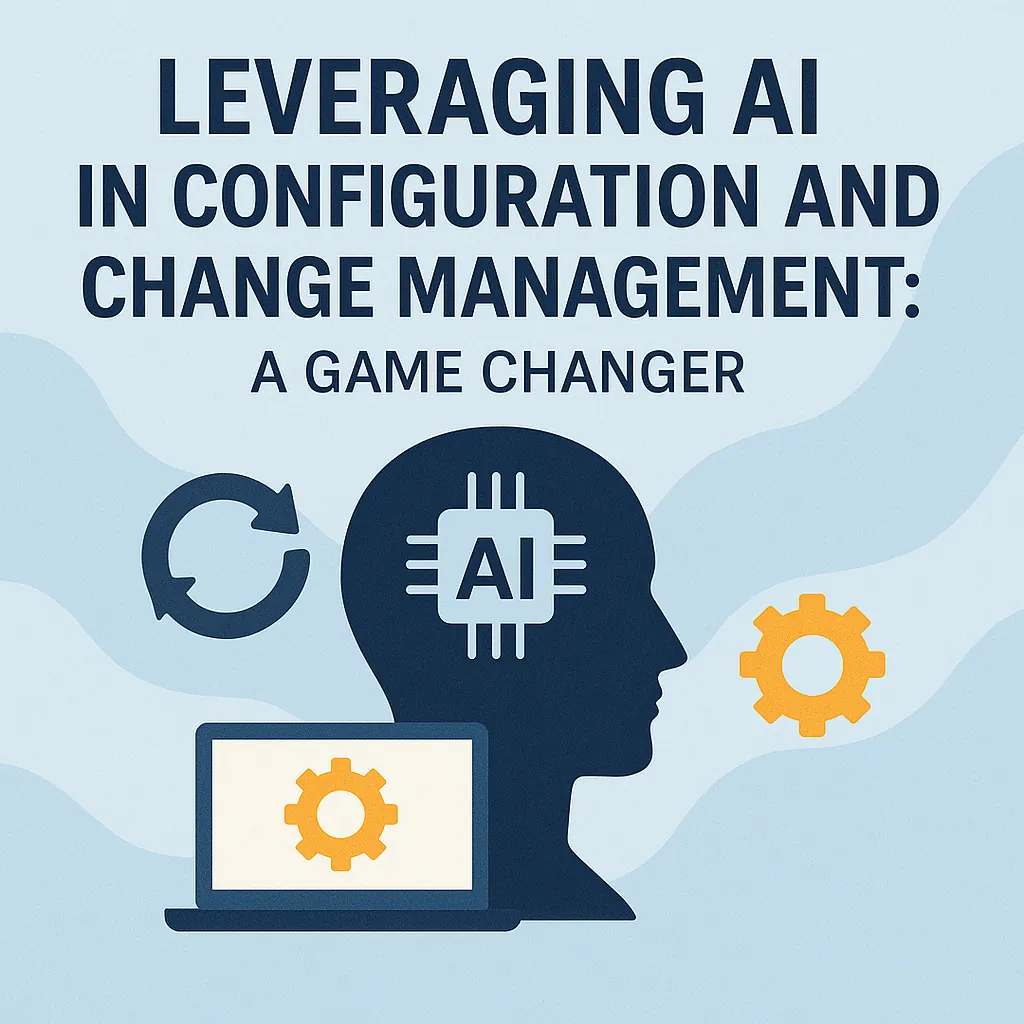Introduction
The concepts of configuration management and change management play pivotal roles in ensuring project success. Understanding the distinction between these two practices is essential for tech-savvy project managers aiming to optimize their workflows and enhance project outcomes.
Configuration Management refers to the systematic process of maintaining the desired state of IT systems and components. It involves defining, documenting, and controlling the configuration of products and services throughout their lifecycle. This practice ensures that all elements of a project are consistent and aligned with the project’s objectives, thereby minimizing risks associated with discrepancies and deviations from the planned configuration [5][3].
On the other hand, Change Management focuses on the processes, plans, and baselines that govern how changes are introduced and managed within a project. It encompasses the identification, documentation, and control of changes to project objectives, ensuring that any modifications are systematically evaluated for their impact on the overall project [11][12]. This practice is crucial for maintaining project integrity and ensuring that all stakeholders are aligned with the evolving project landscape.
The significance of both configuration and change management cannot be overstated. They are complementary practices that, when effectively implemented, contribute to the smooth execution of projects. Configuration management provides a stable foundation by ensuring that all components are correctly configured, while change management allows for flexibility and adaptability in response to new information or shifting project requirements [10][15]. Together, they help mitigate risks, enhance communication among team members, and ultimately drive project success.
As we delve deeper into the intersection of these management practices, it is essential to recognize the transformative impact of Artificial Intelligence (AI). AI technologies are revolutionizing how project managers approach configuration and change management by automating routine tasks, providing predictive analytics, and facilitating real-time decision-making. This integration of AI not only streamlines processes but also enhances the accuracy and efficiency of managing configurations and changes, making it a game changer in the field of project management. By leveraging AI, project managers can focus on strategic decision-making and innovation, rather than getting bogged down by administrative tasks [9][14].
Understanding Configuration Management
Configuration management (CM) is a critical discipline within project management, particularly in the realm of IT service management. It focuses on maintaining the integrity and consistency of a product’s performance and functionality throughout its lifecycle. Here’s a detailed look at configuration management, its objectives, processes, and the tools commonly employed in this field.
Definition and Objectives of Configuration Management
Configuration management is defined as the process of identifying, documenting, and controlling the configuration items (CIs) within an organization’s IT infrastructure. The primary objectives of configuration management include:
- Ensuring Consistency: CM aims to maintain a desired state of IT systems and components, ensuring that they perform consistently and reliably over time [13].
- Facilitating Change: By documenting the current configurations, CM helps organizations manage changes effectively, minimizing disruptions and ensuring that all changes are tracked and approved [10].
- Enhancing Visibility: CM provides a clear view of the system’s components and their relationships, which is essential for troubleshooting and impact analysis when changes are proposed [6].
Processes Involved in Configuration Management
The configuration management process typically involves several key steps:
- Identification: This step involves defining and identifying the configuration items that need to be managed. This includes hardware, software, documentation, and any other components that are part of the IT infrastructure [6].
- Control: Once identified, the configuration items must be controlled. This involves establishing baselines and ensuring that any changes to these items are documented and approved through a formal process [10].
- Status Accounting: This process entails maintaining records of the configuration items and their status, including any changes made, to provide an accurate picture of the current configuration at any time [11].
- Verification and Audit: Regular audits and verifications are conducted to ensure that the configuration items are in compliance with the established baselines and that any discrepancies are addressed promptly [11].
Tools Commonly Used for Configuration Management
Several tools are widely used in configuration management to streamline processes and enhance efficiency. These tools help project managers and IT teams automate tasks, maintain documentation, and ensure compliance. Some of the commonly used tools include:
- Ansible: An open-source automation tool that helps in configuration management, application deployment, and task automation. It allows for the management of systems in a consistent manner [12].
- Puppet: A configuration management tool that automates the provisioning and management of infrastructure, ensuring that systems are configured correctly and consistently [12].
- Chef: Similar to Puppet, Chef is used for automating the configuration of servers and applications, allowing for the management of complex infrastructures [12].
- Terraform: A tool for building, changing, and versioning infrastructure safely and efficiently. It allows for the management of infrastructure as code, which is essential for modern configuration management practices [12].
Understanding Change Management
Change management is a critical aspect of project management that focuses on managing alterations to project plans, processes, and baselines. Its primary objective is to ensure that changes are implemented smoothly and successfully, minimizing disruption while maximizing the benefits of the change. Here are the key points to consider:
Definition and Objectives of Change Management
Definition: Change management refers to the structured approach to transitioning individuals, teams, and organizations from a current state to a desired future state. It encompasses the processes, tools, and techniques used to manage the people side of change to achieve a required business outcome.
Objectives: The main objectives of change management include:
- Ensuring that changes are thoroughly assessed and approved before implementation.
- Minimizing resistance to change by engaging stakeholders and communicating effectively.
- Enhancing the likelihood of successful change adoption and integration into the organization.
Processes Involved in Managing Change Effectively
- Change Identification: Recognizing the need for change, which can arise from various sources such as project scope adjustments, stakeholder feedback, or external factors.
- Change Assessment: Evaluating the potential impact of the proposed change on project objectives, timelines, and resources. This step often involves risk analysis and stakeholder consultation.
- Change Approval: Gaining formal approval from relevant stakeholders or governance bodies before proceeding with the change. This ensures that all parties are aligned and that the change is justified.
- Change Implementation: Executing the approved change while ensuring that all team members are informed and prepared for the transition.
- Change Review: After implementation, reviewing the change to assess its effectiveness and to identify any lessons learned for future changes.
Tools and Methodologies Used in Change Management
- Change Management Systems: These are software tools designed to facilitate the change management process by tracking change requests, approvals, and implementations. They help maintain a clear record of changes and their impacts.
- Agile Methodologies: Agile frameworks, such as Scrum or Kanban, emphasize flexibility and iterative progress, making them well-suited for managing change in dynamic project environments. They encourage regular feedback and adaptation, which can enhance change management efforts.
- Communication Plans: Effective communication is vital in change management. Developing a communication plan that outlines how information about the change will be disseminated to stakeholders can help mitigate resistance and foster acceptance.
- Training and Support: Providing training and support to team members affected by the change is essential for ensuring a smooth transition. This may include workshops, tutorials, or one-on-one coaching sessions.
Incorporating AI technologies into change management practices can further enhance these processes. AI can assist in analyzing data to predict the impact of changes, automating routine tasks, and providing insights that help project managers make informed decisions. By leveraging AI, project managers can streamline change management, making it more efficient and effective in achieving project goals.
Key Differences Between Configuration Management and Change Management
Understanding the distinctions between configuration management and change management is crucial for effective project execution. Both practices play vital roles in ensuring project success, but they serve different purposes and involve distinct processes. Here’s a detailed comparison to help tech-savvy project managers navigate these two essential management practices.
Goals of Configuration Management vs. Change Management
- Configuration Management aims to maintain the integrity and consistency of a product’s performance and its functional and physical attributes throughout its lifecycle. It focuses on managing the configurations of project artifacts, ensuring that all components are correctly identified, documented, and controlled. This practice is essential for maintaining system stability and reliability, especially in complex IT environments [6][12].
- Change Management, on the other hand, is centered around managing changes to project processes, plans, and baselines. Its primary goal is to ensure that any alterations to the project are systematically evaluated, approved, and implemented without disrupting ongoing operations. Change management is about understanding the “how,” “when,” and “why” of changes, ensuring that they align with project objectives and stakeholder expectations [1][4].
Processes and Methodologies Involved
Configuration Management involves several key processes, including:
- Configuration Identification: Defining and documenting the components of the system.
- Configuration Control: Managing changes to the configuration items and ensuring that any modifications are documented and approved.
- Configuration Status Accounting: Keeping track of the status of configuration items and their changes over time.
- Configuration Audits: Verifying that the configuration items are consistent with their specifications and requirements [7][14].
Change Management encompasses a different set of processes, which typically include:
- Change Request Submission: Documenting and submitting requests for changes.
- Impact Analysis: Assessing the potential effects of proposed changes on the project scope, schedule, and budget.
- Change Approval: Gaining necessary approvals from stakeholders before implementing changes.
- Change Implementation: Executing the approved changes and ensuring that they are integrated into the project [3][12].
Expected Outcomes from Each Practice
The expected outcomes of Configuration Management include:
- Enhanced system reliability and performance through controlled changes.
- Improved traceability of configuration items, which aids in troubleshooting and maintenance.
- A clear understanding of the current system state, facilitating better decision-making and planning [10][12].
In contrast, Change Management aims to achieve:
- A structured approach to managing changes, reducing the risk of project disruptions.
- Increased stakeholder satisfaction by ensuring that changes are communicated and managed effectively.
- Better alignment of changes with project goals, leading to more successful project outcomes [8][13].
The Role of AI in Configuration Management
Particularly within the IT sector, the integration of Artificial Intelligence (AI) into configuration management practices is proving to be a transformative force. As organizations strive to maintain a competitive edge, leveraging AI technologies can significantly enhance the efficiency and effectiveness of configuration management processes. Here are some key points illustrating the impact of AI in this area:
- Automation of Configuration Processes: AI applications are increasingly being utilized to automate various configuration management tasks. This includes the automatic detection of changes in system configurations, which can reduce the manual effort required and minimize human error. By automating routine tasks, project managers can focus on more strategic activities, thereby improving overall productivity and project outcomes.
- Predictive Analytics for Configuration Issues: One of the most powerful applications of AI in configuration management is the use of predictive analytics. AI algorithms can analyze historical data and identify patterns that may indicate potential configuration issues before they arise. This proactive approach allows project managers to address problems early, reducing downtime and ensuring that systems remain stable and reliable. For instance, predictive models can forecast when a system is likely to require updates or maintenance, enabling teams to plan accordingly.
AI Tools for Configuration Management: Several AI-driven tools are available that facilitate configuration management. These tools often incorporate machine learning capabilities to continuously improve their performance. Examples include:
- ServiceNow: This platform uses AI to automate IT service management, including configuration management, by providing insights into system performance and potential issues.
- Ansible: An open-source automation tool that leverages AI to manage configurations across multiple systems, ensuring consistency and compliance.
- Puppet: This tool employs AI to automate the deployment and management of software configurations, allowing for rapid scaling and adaptation to changing project requirements.
By integrating AI technologies into configuration management, project managers can not only streamline processes but also enhance their ability to respond to changes in a dynamic project environment. The combination of automation, predictive analytics, and advanced tools positions organizations to better manage their IT assets and maintain a desired state of system performance, ultimately leading to more successful project outcomes.
The Role of AI in Change Management
In the context of change management, the integration of Artificial Intelligence (AI) technologies is proving to be transformative. As organizations strive to adapt to rapid technological advancements and evolving market demands, AI offers innovative solutions that enhance the efficiency and effectiveness of change management practices. Here are some key points illustrating the impact of AI on change management:
- Streamlining Change Request Processes: AI can significantly reduce the time and effort involved in processing change requests. By automating routine tasks such as data entry, approval workflows, and notifications, AI systems can facilitate quicker decision-making. For instance, AI-driven chatbots can assist project managers by providing instant responses to common queries related to change requests, thereby freeing up valuable time for more strategic activities. This automation not only speeds up the process but also minimizes human error, ensuring that requests are handled consistently and accurately.
- Assessing Change Impact and Risks: One of the critical challenges in change management is understanding the potential impact of proposed changes on existing systems and processes. AI can analyze vast amounts of data to predict how changes might affect various aspects of a project. Machine learning algorithms can identify patterns and correlations that may not be immediately apparent to human analysts. For example, AI tools can simulate different scenarios to evaluate the risks associated with a change, helping project managers make informed decisions. This predictive capability allows for proactive risk mitigation strategies, ultimately leading to smoother transitions during change implementation.
- Examples of AI Solutions Supporting Change Management: Several AI solutions are currently available that cater specifically to change management needs. Tools like ServiceNow and Jira incorporate AI functionalities to enhance change management processes. For instance, ServiceNow uses AI to automate incident management and change requests, providing insights into past changes and their outcomes. Similarly, Jira’s AI capabilities can help prioritize change requests based on their potential impact and urgency, ensuring that project teams focus on the most critical changes first. These solutions not only improve efficiency but also enhance collaboration among team members by providing a centralized platform for managing changes.
Synergies Between Configuration Management and Change Management with AI
The integration of Artificial Intelligence (AI) into configuration management and change management practices is proving to be a transformative force. By leveraging AI technologies, organizations can enhance collaboration between these two critical management disciplines, leading to improved efficiency and outcomes. Here are some key points to consider:
Fostering Collaboration Between Teams
- Enhanced Communication: AI tools can facilitate real-time communication between configuration management and change management teams. By utilizing chatbots and AI-driven platforms, teams can share updates, track changes, and manage configurations seamlessly, reducing the chances of miscommunication and errors [10].
- Data-Driven Decision Making: AI can analyze vast amounts of data from both management practices, providing insights that help teams make informed decisions. This data-driven approach ensures that changes are aligned with the current configuration state, minimizing disruptions and enhancing project stability [12].
Case Studies and Examples
- AI in Action: Companies like IBM have implemented AI-driven solutions that integrate change and configuration management processes. For instance, IBM’s Watson AI analyzes historical change data to predict the impact of proposed changes on system configurations, allowing teams to proactively address potential issues before they arise [9].
- Success Stories: A leading financial institution utilized AI to automate their change management processes, resulting in a 30% reduction in change-related incidents. By integrating AI with their configuration management database, they achieved a more accurate representation of their IT environment, which in turn improved their change approval workflows [6].
Best Practices for Integrating AI
- Start Small: Begin by identifying specific areas within configuration and change management where AI can add value. This could involve automating routine tasks or enhancing data analysis capabilities. Gradually expand AI applications as teams become more comfortable with the technology [11].
- Training and Development: Invest in training for project managers and team members to ensure they understand how to leverage AI tools effectively. This includes familiarizing them with AI-driven analytics, automation tools, and collaborative platforms that enhance both management practices [10].
- Continuous Improvement: Establish a feedback loop where teams can share their experiences with AI integration. This will help identify challenges and opportunities for improvement, ensuring that the AI tools evolve alongside the needs of the organization [12].
By embracing AI technologies, project managers can create a synergistic relationship between configuration management and change management. This integration not only streamlines processes but also fosters a culture of collaboration and continuous improvement, ultimately leading to more successful project outcomes.
Challenges and Considerations of Implementing AI
Integrating AI technologies into configuration and change management practices presents a unique set of challenges for project managers. While AI can significantly enhance efficiency and decision-making, understanding and addressing these obstacles is crucial for successful implementation. Here are some common challenges, the importance of training, and strategies to overcome these hurdles:
Common Obstacles in Adopting AI Technologies
- Resistance to Change: One of the most significant barriers to AI adoption is the resistance from team members who may be apprehensive about new technologies. This resistance can stem from fear of job displacement or a lack of understanding of AI’s benefits [5][9].
- Data Quality and Availability: AI systems rely heavily on data for training and operation. Poor data quality or insufficient data can lead to ineffective AI solutions. Ensuring that data is accurate, relevant, and accessible is a critical challenge [9][10].
- Integration with Existing Systems: Integrating AI tools with current project management systems can be complex. Compatibility issues may arise, requiring additional resources and time to resolve [6][9].
- Skill Gaps: Many project teams may lack the necessary skills to implement and manage AI technologies effectively. This gap can hinder the successful deployment of AI solutions [5][9].
Importance of Training and Change Management in AI Adoption
Training is essential for ensuring that team members are equipped to work with AI technologies. Effective training programs can help alleviate fears and build confidence in using new tools. Additionally, change management practices are vital to facilitate a smooth transition. This includes:
- Communicating the Benefits: Clearly articulating how AI will improve processes and outcomes can help gain buy-in from stakeholders [5][9].
- Providing Ongoing Support: Continuous support and resources for team members can ease the transition and encourage the adoption of AI tools [6][9].
Strategies for Overcoming Challenges in AI Implementation
- Develop a Clear AI Strategy: Establishing a well-defined strategy that outlines the goals, expected outcomes, and implementation steps can guide the adoption process and align team efforts [5][9].
- Invest in Training Programs: Prioritizing training initiatives that focus on both technical skills and change management can empower team members to embrace AI technologies confidently [5][9].
- Foster a Culture of Innovation: Encouraging a culture that values experimentation and innovation can help mitigate resistance to change. This can be achieved by celebrating small wins and recognizing team members who contribute to AI initiatives [6][9].
- Utilize Pilot Programs: Implementing AI solutions through pilot programs allows teams to test and refine processes before a full-scale rollout. This approach can help identify potential issues early and adjust strategies accordingly [5][9].
- Engage Stakeholders Early: Involving key stakeholders in the planning and implementation phases can ensure that their concerns are addressed and that they feel invested in the process [5][9].
By acknowledging these challenges and implementing effective strategies, project managers can leverage AI technologies in configuration and change management, ultimately enhancing project outcomes and stakeholder satisfaction.
Conclusion
Understanding the distinctions between configuration management and change management is crucial for ensuring the smooth operation of IT services.
- Differences and Importance: Configuration management focuses on identifying, documenting, and controlling the configuration items (CIs) within an organization’s IT infrastructure, ensuring that systems maintain a desired state and perform consistently [11]. In contrast, change management is concerned with tracking, approving, and implementing changes to these configurations, thereby managing the impact of modifications on IT services [2][10]. Recognizing these differences allows project managers to effectively navigate the complexities of IT service management, minimizing risks and optimizing outcomes [12].
- Benefits of Leveraging AI: The integration of AI technologies into both configuration and change management practices can significantly enhance efficiency and effectiveness. AI can uncover hidden patterns, identify potential bottlenecks, and forecast the impact of proposed changes with remarkable accuracy [6]. By automating routine tasks and providing data-driven insights, AI empowers project managers to make informed decisions, streamline processes, and ultimately improve service delivery [5].
- Encouragement to Explore AI Tools: As tech-savvy project managers, embracing AI tools and strategies can be a game changer for your projects. By leveraging AI in configuration and change management, you can enhance your ability to manage complexities, adapt to changes swiftly, and maintain a competitive edge in the fast-evolving tech landscape. Explore the various AI solutions available and consider how they can be integrated into your management practices to drive success in your projects.
In summary, the synergy between configuration management, change management, and AI presents a powerful opportunity for project managers to elevate their practices and achieve superior results. Embrace this technological evolution and position yourself at the forefront of project management innovation.
Find out more about Shaun Stoltz https://www.shaunstoltz.com/about/.
This post was written by an AI and reviewed/edited by a human.



